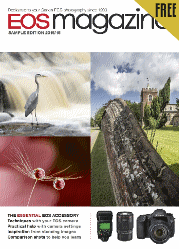
 Flash vs. high ISO
Flash vs. high ISO
In a recent article, we explored just how good the higher ISO settings are on today's Canon EOS cameras, and whether there are times when you still need to use flash. The results were far from conclusive.
Spot the difference...
The ISO range of EOS digital single-lens reflex cameras has seen a sharp increase since the EOS D30 was introduced in 2000. This early camera offered ISO values from 100 to 1600. Today, a camera such as the EOS 6D has a standard range up to ISO 12,800, expandable up to ISO 25,600. The EOS 5D Mark IV goes even higher, with an expandable range up to ISO 102,400 – 64 times the range of the EOS D30 over a period of 16 years.
This got us thinking. Is it now possible to use a high ISO value in low light when previously flash illumination would have been essential? The answer is obviously yes, but there are pros and cons to using ISO values in the upper reaches of the range. On the other hand, shooting with flash also has its upsides and downsides.
The comparison shots below are interesting, but not decisive in favour of using exclusively high ISO settings or an external flash, such as a Canon Speedlie.
See which you prefer, and whether you can spot instantly which is which.
This first set is probably the easiest to work out.


The grainer-looking image on the left was shot at ISO 20000 (1/60 second at f4.5). The image on the right was shot with flash at ISO 160 (1 second at f9, with deliberate camera movement to blur the lights, whilst the short flash duration kept the face sharp).
Again, this one should be easy to guess, but which do you prefer?


The shot without flash (left) gives more natural colours to the fur (ISO 1600), but there's a welcoming warmth about the shot taken with flash.
How about this pair of seaside images?


Shot late into the afternoon, the shot without flash (left) only needed a modest ISO 1600, but the shadows are quite deep. We think the image shot with flash (ISO 100, 1/60 second at f4) makes the subject stand out better against the darker background.
And the last set... which one used flash?


Around half of us at EOS HQ guessed incorrectly! The shot on the left is the one with flash, with the light bounced off a white ceiling (ISO 100, 1/60 second at f10). The right-hand image has light coming from a window which is reflecting off the skins of these clementines and was shot at ISO 2500, 1/45 second at f13.
Try for yourself
When used to their strengths and with suitable subjects, both techniques have their merits. So if you have the luxury of time (and a Speedlite), we recommend you test both options.
About this article
This article excerpt has been taken from the April-June 2017 issue of EOS magazine called 'Flash or no flash?'. You can get a copy of this issue via EOS shop.

Like this? Learn more
about your EOS system
Join EOS magazine today
from only £24.95 a year


We promise never to share your information




 Free sampler
Free sampler